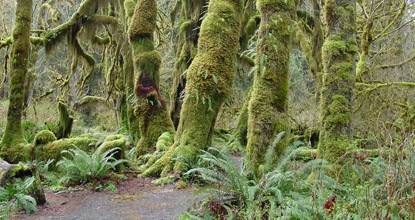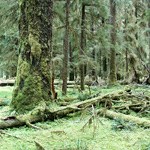Precipitation In The Temperate Rainforest
Temperate Pelting Forests

Ocean-Born Forests
The lush forests in the Quinault, Queets, Hoh, and Bogachiel valleys are some of the most spectacular examples of primeval temperate rain woods in the lower 48 states. These rain forests in one case stretched from southern Oregon to southeast Alaska, just piffling remains outside of protected areas. Other temperate rain forests abound in a few isolated spots around the globe including Chile, New Zealand and southern Commonwealth of australia.
Recipe for Olympic's Temperate Rain Wood
- Rain—lots of it. Storms off the Pacific Ocean drop much of their wet on these westward-facing valleys. Precipitation in Olympic'due south rain forest ranges from 140 to 167 inches (12 to fourteen feet) every year.
- Moderate temperatures. In these low top valleys the temperature seldom drops beneath freezing and summer highs rarely exceed lxxx°F.
- Epiphytes, or plants growing on other plants. Mosses, spike mosses, ferns and lichens festoon tree trunks and branches, giving the woods a "jungle-like" feel.
- Big, sometime trees. The ascendant species are Sitka spruce and western hemlock, but other conifers and several deciduous species grow as well. Many are 100s of years sometime and can reach 250 feet in superlative and thirty to sixty feet in circumference.
- Nurse logs. Because of the densely covered basis, many seedlings instead germinate on fallen, decaying trees. As they grow, their roots reach to the ground. When the log eventually rots away, a colonnade, or row of trees on stilt-like roots, remains.
- Expressionless wood. When the massive trees die, they eventually fall, simply can have centuries to slowly decay back to the soil. Throughout their long expiry, they provide important habitat for whole communities, including mosses, tree seedlings, fungi, modest mammals, amphibians, and insects.
- Roosevelt elk. The thick, layered canopy above moderates the temperature year-round for wildlife, including the largest wild populations of Roosevelt elk in the U.S. On the wood floor, elk browsing shapes the advent of their forest home.
Where To Come across Temperate Rain Forests
The due west-facing Quinault, Queets, Hoh and Bogachiel river valleys all host rain wood. Trails and admission roads offer visitors a way to explore of this verdant ecosystem.

Common Copse
Sitka bandbox - Picea sitchensis
Douglas-fir - Pseudotsuga menziesii
Western hemlock - Tsuga heterophylla
Western redcedar - Thuja plicata
Bigleaf maple - Acer macrophyllum
Vine maple - Acer circinatum
Cherry alder - Alnus rubra
Black cottonwood - Populus balsamifera
For a comparing Tree ID with photos of these common species, visit the Hoh Rainforest Flora and Creature section!
Common Shrubs
Salmonberry - Rubus spectabilis
Blueberry - Vaccinium sp.
Mutual Epiphytes
(plants growing on tree trunks & branches)
Licorice fern - Polypodium glycyrrhiza
Oregon selaginella - Selaginella oregana
True cat-tail moss - Isothecium stoloniferum
Lungwort - Lobaria sp.
Common Understory Plants
Oregon oxalis - Oxalis oregana
Sword fern - Polystichum munitum
Lady fern - Athyrium felix-femina
Stair-step moss - Hylocomium splendens
100s of other species of mosses, lichens and liverworts
Concluding updated: September half dozen, 2020
Precipitation In The Temperate Rainforest,
Source: https://www.nps.gov/olym/learn/nature/temperate-rain-forests.htm
Posted by: smileytheighty.blogspot.com


0 Response to "Precipitation In The Temperate Rainforest"
Post a Comment